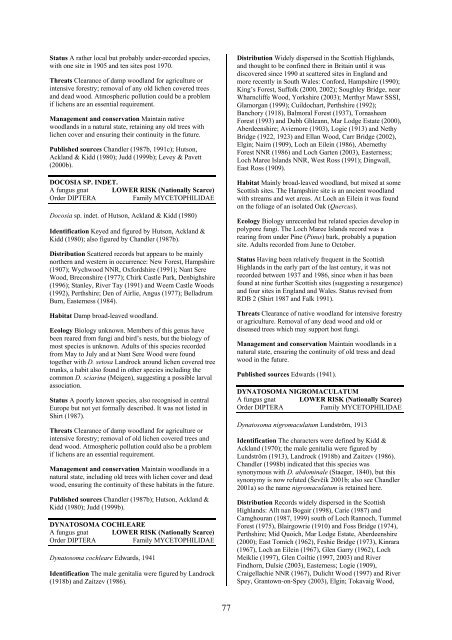Part 2: Nematocera and Aschiza not dealt with by Falk (1991) - JNCC
Part 2: Nematocera and Aschiza not dealt with by Falk (1991) - JNCC
Part 2: Nematocera and Aschiza not dealt with by Falk (1991) - JNCC
Create successful ePaper yourself
Turn your PDF publications into a flip-book with our unique Google optimized e-Paper software.
Status A rather local but probably under-recorded species,<br />
<strong>with</strong> one site in 1905 <strong>and</strong> ten sites post 1970.<br />
Threats Clearance of damp woodl<strong>and</strong> for agriculture or<br />
intensive forestry; removal of any old lichen covered trees<br />
<strong>and</strong> dead wood. Atmospheric pollution could be a problem<br />
if lichens are an essential requirement.<br />
Management <strong>and</strong> conservation Maintain native<br />
woodl<strong>and</strong>s in a natural state, retaining any old trees <strong>with</strong><br />
lichen cover <strong>and</strong> ensuring their continuity in the future.<br />
Published sources Ch<strong>and</strong>ler (1987b, <strong>1991</strong>c); Hutson,<br />
Ackl<strong>and</strong> & Kidd (1980); Judd (1999b); Levey & Pavett<br />
(2000b).<br />
DOCOSIA SP. INDET.<br />
A fungus gnat LOWER RISK (Nationally Scarce)<br />
Order DIPTERA<br />
Family MYCETOPHILIDAE<br />
Docosia sp. indet. of Hutson, Ackl<strong>and</strong> & Kidd (1980)<br />
Identification Keyed <strong>and</strong> figured <strong>by</strong> Hutson, Ackl<strong>and</strong> &<br />
Kidd (1980); also figured <strong>by</strong> Ch<strong>and</strong>ler (1987b).<br />
Distribution Scattered records but appears to be mainly<br />
northern <strong>and</strong> western in occurrence: New Forest, Hampshire<br />
(1907); Wychwood NNR, Oxfordshire (<strong>1991</strong>); Nant Sere<br />
Wood, Breconshire (1977); Chirk Castle Park, Denbighshire<br />
(1996); Stanley, River Tay (<strong>1991</strong>) <strong>and</strong> Weem Castle Woods<br />
(1992), Perthshire; Den of Airlie, Angus (1977); Belladrum<br />
Burn, Easterness (1984).<br />
Habitat Damp broad-leaved woodl<strong>and</strong>.<br />
Ecology Biology unknown. Members of this genus have<br />
been reared from fungi <strong>and</strong> bird’s nests, but the biology of<br />
most species is unknown. Adults of this species recorded<br />
from May to July <strong>and</strong> at Nant Sere Wood were found<br />
together <strong>with</strong> D. setosa L<strong>and</strong>rock around lichen covered tree<br />
trunks, a habit also found in other species including the<br />
common D. sciarina (Meigen), suggesting a possible larval<br />
association.<br />
Status A poorly known species, also recognised in central<br />
Europe but <strong>not</strong> yet formally described. It was <strong>not</strong> listed in<br />
Shirt (1987).<br />
Threats Clearance of damp woodl<strong>and</strong> for agriculture or<br />
intensive forestry; removal of old lichen covered trees <strong>and</strong><br />
dead wood. Atmospheric pollution could also be a problem<br />
if lichens are an essential requirement.<br />
Management <strong>and</strong> conservation Maintain woodl<strong>and</strong>s in a<br />
natural state, including old trees <strong>with</strong> lichen cover <strong>and</strong> dead<br />
wood, ensuring the continuity of these habitats in the future.<br />
Published sources Ch<strong>and</strong>ler (1987b); Hutson, Ackl<strong>and</strong> &<br />
Kidd (1980); Judd (1999b).<br />
DYNATOSOMA COCHLEARE<br />
A fungus gnat LOWER RISK (Nationally Scarce)<br />
Order DIPTERA<br />
Family MYCETOPHILIDAE<br />
Dynatosoma cochleare Edwards, 1941<br />
Identification The male genitalia were figured <strong>by</strong> L<strong>and</strong>rock<br />
(1918b) <strong>and</strong> Zaitzev (1986).<br />
Distribution Widely dispersed in the Scottish Highl<strong>and</strong>s,<br />
<strong>and</strong> thought to be confined there in Britain until it was<br />
discovered since 1990 at scattered sites in Engl<strong>and</strong> <strong>and</strong><br />
more recently in South Wales: Conford, Hampshire (1990);<br />
King’s Forest, Suffolk (2000, 2002); Soughley Bridge, near<br />
Wharncliffe Wood, Yorkshire (2003); Merthyr Mawr SSSI,<br />
Glamorgan (1999); Cuildochart, Perthshire (1992);<br />
Banchory (1918), Balmoral Forest (1937), Tornasheen<br />
Forest (1993) <strong>and</strong> Dubh Ghleann, Mar Lodge Estate (2000),<br />
Aberdeenshire; Aviemore (1903), Logie (1913) <strong>and</strong> Nethy<br />
Bridge (1922, 1923) <strong>and</strong> Ellan Wood, Carr Bridge (2002),<br />
Elgin; Nairn (1909), Loch an Eilein (1986), Abernethy<br />
Forest NNR (1986) <strong>and</strong> Loch Garten (2003), Easterness;<br />
Loch Maree Isl<strong>and</strong>s NNR, West Ross (<strong>1991</strong>); Dingwall,<br />
East Ross (1909).<br />
Habitat Mainly broad-leaved woodl<strong>and</strong>, but mixed at some<br />
Scottish sites. The Hampshire site is an ancient woodl<strong>and</strong><br />
<strong>with</strong> streams <strong>and</strong> wet areas. At Loch an Eilein it was found<br />
on the foliage of an isolated Oak (Quercus).<br />
Ecology Biology unrecorded but related species develop in<br />
polypore fungi. The Loch Maree Isl<strong>and</strong>s record was a<br />
rearing from under Pine (Pinus) bark, probably a pupation<br />
site. Adults recorded from June to October.<br />
Status Having been relatively frequent in the Scottish<br />
Highl<strong>and</strong>s in the early part of the last century, it was <strong>not</strong><br />
recorded between 1937 <strong>and</strong> 1986, since when it has been<br />
found at nine further Scottish sites (suggesting a resurgence)<br />
<strong>and</strong> four sites in Engl<strong>and</strong> <strong>and</strong> Wales. Status revised from<br />
RDB 2 (Shirt 1987 <strong>and</strong> <strong>Falk</strong> <strong>1991</strong>).<br />
Threats Clearance of native woodl<strong>and</strong> for intensive forestry<br />
or agriculture. Removal of any dead wood <strong>and</strong> old or<br />
diseased trees which may support host fungi.<br />
Management <strong>and</strong> conservation Maintain woodl<strong>and</strong>s in a<br />
natural state, ensuring the continuity of old tress <strong>and</strong> dead<br />
wood in the future.<br />
Published sources Edwards (1941).<br />
DYNATOSOMA NIGROMACULATUM<br />
A fungus gnat LOWER RISK (Nationally Scarce)<br />
Order DIPTERA<br />
Family MYCETOPHILIDAE<br />
Dynatosoma nigromaculatum Lundström, 1913<br />
Identification The characters were defined <strong>by</strong> Kidd &<br />
Ackl<strong>and</strong> (1970); the male genitalia were figured <strong>by</strong><br />
Lundström (1913), L<strong>and</strong>rock (1918b) <strong>and</strong> Zaitzev (1986).<br />
Ch<strong>and</strong>ler (1998b) indicated that this species was<br />
synonymous <strong>with</strong> D. abdominale (Staeger, 1840), but this<br />
synonymy is now refuted (Ševčík 2001b; also see Ch<strong>and</strong>ler<br />
2001a) so the name nigromaculatum is retained here.<br />
Distribution Records widely dispersed in the Scottish<br />
Highl<strong>and</strong>s: Allt nan Bogair (1998), Carie (1987) <strong>and</strong><br />
Camghouran (1987, 1999) south of Loch Rannoch, Tummel<br />
Forest (1975), Blairgowrie (1910) <strong>and</strong> Foss Bridge (1974),<br />
Perthshire; Mid Quoich, Mar Lodge Estate, Aberdeenshire<br />
(2000); East Tomich (1962), Feshie Bridge (1973), Kinrara<br />
(1967), Loch an Eilein (1967), Glen Garry (1962), Loch<br />
Meiklie (1997), Glen Coiltie (1997, 2003) <strong>and</strong> River<br />
Findhorn, Dulsie (2003), Easterness; Logie (1909),<br />
Craigellachie NNR (1967), Dulicht Wood (1997) <strong>and</strong> River<br />
Spey, Grantown-on-Spey (2003), Elgin; Tokavaig Wood,<br />
77
















